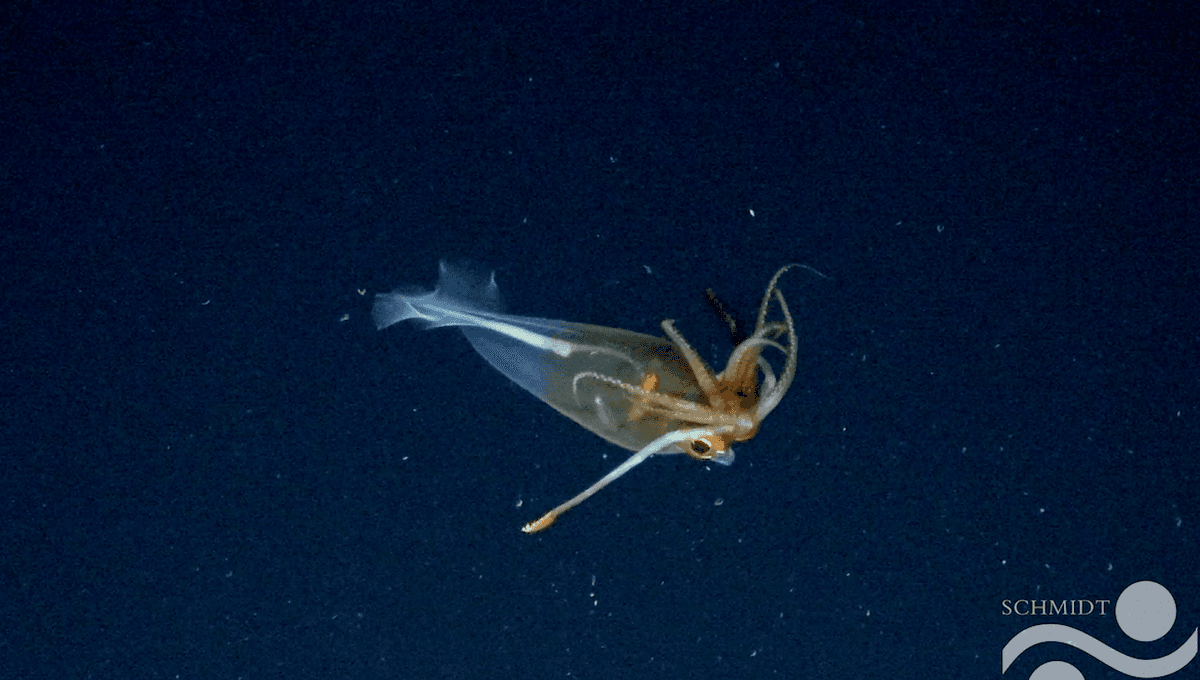
When an iceberg broke away from Antarctica in January, it opened up a rare opportunity for scientists to explore a pristine seafloor ecosystem that was once hidden beneath an ice shelf. To their astonishment, the research team captured the first confirmed footage of the elusive glacial glass squid (Galiteuthis glacialis), among many other deep-sea weirdos.
The surprisingly cute squid was spotted at a depth of 687 meters (2,254 feet) on January 20, 2025, in the Southern Ocean near Antarctica. While the species was first identified in 1906, this marks the first confirmed footage of a live individual in the wild. Until now, sightings have only come from dead specimens either hauled up in fishing nets or chewed up in the bellies of whales.
Researchers aboard the Schmidt Ocean Institute’s R/V Falkor (too) made the discovery after diverting their course toward this section of the Bellingshausen Sea. The detour was prompted by news that a city-sized iceberg, named A-84, had broken off from Antarctica’s George VI Ice Shelf, exposing a long-concealed stretch of seafloor.
The team noted that G. glacialis bears a strong resemblance to a juvenile colossal squid (Mesonychoteuthis hamiltoni) – another deep-sea species they managed to capture the first-ever live footage of during their next expedition on March 9.
Both species belong to the glass squid family and are known for their transparent bodies, though the colossal squid is believed to darken as it matures. They also share a distinctive feature in the form of sharp hooks used for hunting in the dingy depths of the ocean. However, the placement of the hooks differs: on the colossal squid, they are located along the middle of its eight arms, while in the glacial glass squid, they appear at the tips of its two elongated tentacles.
Perhaps the most striking difference is size. The colossal squid can grow to an astonishing 7 meters (23 feet) in length, whereas the glacial glass squid remains far smaller throughout its life. Nevertheless, if the colossal squid is young, like this one, it can be difficult to tell the species apart.
To ensure accurate identification, the team called on independent squid experts – Dr Aaron Evans and Dr Kat Bolstad – who confirmed the distinctions and concluded that the specimens belonged to two previously undocumented species.
“The first sighting of two different squids on back-to-back expeditions is remarkable and shows how little we have seen of the magnificent inhabitants of the Southern Ocean,” Schmidt Ocean Institute’s executive director, Dr Jyotika Virmani, said in a statement.
“Fortunately, we caught enough high-resolution imagery of these creatures to allow the global experts, who were not on the vessel, to identify both species,” she added.
The colossal squid and glacial glass squid may be the stars of the show, but the Schmidt Ocean Institute documented many more deep-sea creatures during their recent expedition in the waters off Antarctica, including icefish, giant sea spiders, and octopuses.
“These unforgettable moments continue to remind us that the ocean is brimming with mysteries yet to be solved,” Virmani added.
Source Link: After An Iceberg Split Off Antarctica, A Glacial Glass Squid Was Caught On Camera For First Time